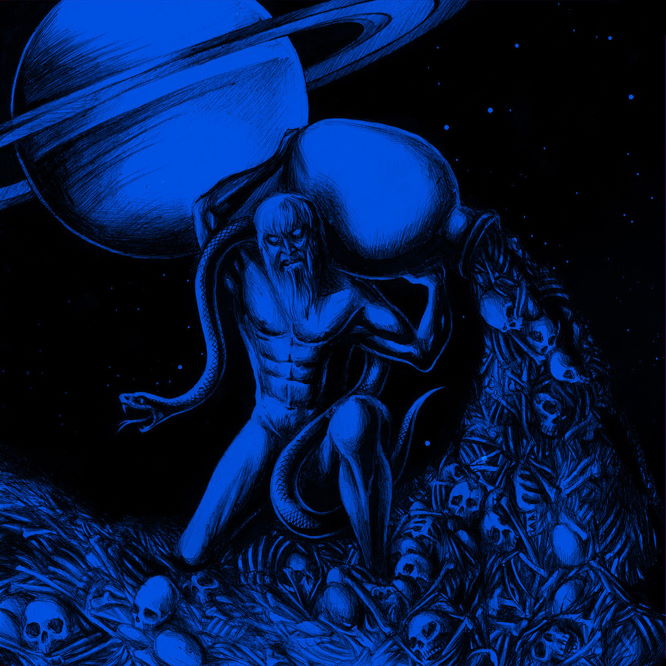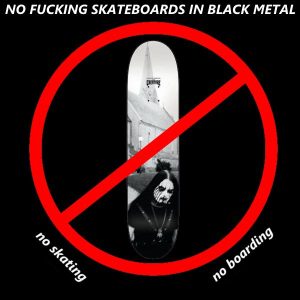Year of release: 2019
Label: Thou Shalt Kill! Records
Rating: 7,8 / 10
ŁATANU's new album took one of the first positions in my expectations list since the moment I first heard the news about working on it. Unfortunately, the expectations were not fully met. Before us is the direct sequel of “Čorny manalit”, with only slightly more pronounced positive and negative sides.
The first parallel comes to mind: both albums take a sharp start, and then slow down a bit. The debut began with the killer hits “Łatanu” and “Pandemija śmierci”, and the novelty shoots a pair of “Amiń!” and “Uračystaść Tvajoj pieramohi”. These are songs of .666 caliber, piercing through armor of any thickness and getting stuck in the brain. After listening to the album, for a few more days you can't stop repeating the main refrains. Also the first couple of songs contain the best riffs.
The remaining songs are also good, but not so good. And here, too, everything works in pairs. “Suprać sonca” and “Śmierć idzie nasustrač” proudly carry the champion banner behind the first pair. “Pakul nia budzie zachoplena nieba” is lacking identity: this is a fairly standard Black Metal thing that can be painlessly applied in the work of some other band. “Eon Hora”, the final song, is retained in memory mostly because of the multiple repeating of the refrain. For me it causes the most mixed feelings. On the one hand, the slowness of the composition creates a very negative atmosphere, oozing snake venom. On the other hand, it’s quite obvious that faster songs of ŁATANU work much better, even despite all the band’s efforts to enrich the guitar parts of the title song. As far as I understand, Plague666 is the author of this trackbut that doesn’t change anything, because PESTILENTIA's best songs are also fast.
A positive moment - it seems that P.Z. finally departed from the NIEZGAL heritage.It is clear that the similarity is still felt, however, on “Eon Hora” there are no longer any hard rhythmic frames characteristic of NIEZGAL (excluding the posthumous album). The music here is based on P.Z.'s trademark intricate tremole riffs, perfectly fitting into high speed blast beat songs. It is very interesting to observe how they seem to twist into spirals and are pulled into knots, gradually weaving a large canvas. The connection with the music of PESTILENTIA, which I feel at the debut, has also practically disappeared. The recognizable Niemaracz's melodiousness is the only parallel (in addition to Plague666 behind the drum kit, of course). It is unlikely that the independence of ŁATANU can now cause doubt for anyone.
Summing up the songs as such, I’ll say that they are no worse than at “Čorny manalit”, but no better either. But I liked the lyrics more. In general, the texts revolve around immortal topics, but they are written very eloquently, with an inner fire. That's the plus of using mother language: no way you can write something like that in English, it all comes down to hackneyed stuff about "possessed by evil force", and even if you print this with capital letters, nobody will read this bullshit to the end. "Sonm čornych demanaŭ piekła žorstka katuje moj rozum" - that's a different matter!
Now to the sound that turned out to be a stumbling block for me, which made me listen to the album 15 times more than usually required to write a review. It’s hard to explain what’s wrong with it. The sound was made by exactly the same people as last time, and the result didn’t seem to be very different, but ... “Čorny manalit” seems to be worse in terms of all quality parameters: it is quieter, dirtier, slightly blurred. At the same time, it easily creates an otherworldly sensation, and a small echo effect gives the sound depth and solidity. “Eon Hora” is louder, more distinct, but its sound picture seems incomplete. It was as if the album was recorded in “live in garage” mode, and then Sadist, doing mastering, was too keen on cleaning up the sound. For example, I can hear bass parts only at the last track. But on “Čorny manalit” it had almost equal rights with a guitar! In general, the sound on “Eon Hora” somehow combines lively rudeness with sterility, and it is difficult to chew it on a subconscious level. The vocals make their contribution: at the debut, Nihilation shouted in inhuman from the depths of chaos. Here, he growls hoarsely somewhere nearby. The brain and ears are trying to work in two directions, this is a little distracting.
At last, about the physical edition. The digipak, limited to 366 copies, features a cover art by Horth. Some barely perceptible clumsiness makes his work related to the ever-memorable cover of “Čorny manalit”, but this, of course, is good - the continuity is observed. Moreover, the meaning of the cover is fully consistent with the album. Inside, you can find art by José Gabriel Alegria Sabogal, a Peruvian visionary artist who, for example, designed the new MEPHORASH. The CD sleeve features a new logo created by the joint efforts of KRUK and APHOOM ZHAH members Twilight One and Vaiug. A strange solution is immediately revealed: on the inside, two panels of the digipak are completely empty (okay, there are dots symbolizing the stars in the night sky). At the same time, all the lyrics are placed on the third outer panel, as a result of which it has to be read under a magnifying glass. A very… peculiar concept. All details on a video.
Despite all the problems described above, “Eon Hora” is, of course, one of these must have albums, like any other work of Niemaracz Clan bands. This is the face of modern Krywian Black Metal. It will be extremely interesting to listen to the album at a concert - some of the material from it ŁATANU has already been played before, but now that the songs are memorized in the studio version, I want to compare them with live versions. While we are waiting for the return of ŁATANU to the stage, it is time for me to start making an interview with the band, because that has long been hanging on the agenda. By the way, almost comprehensive material about ŁATANU and NIEZGAL already exists on the pages of the first issue of Black Curse fanzine, but now I finally have the opportunity to add information about “Eon Hora” to it.



